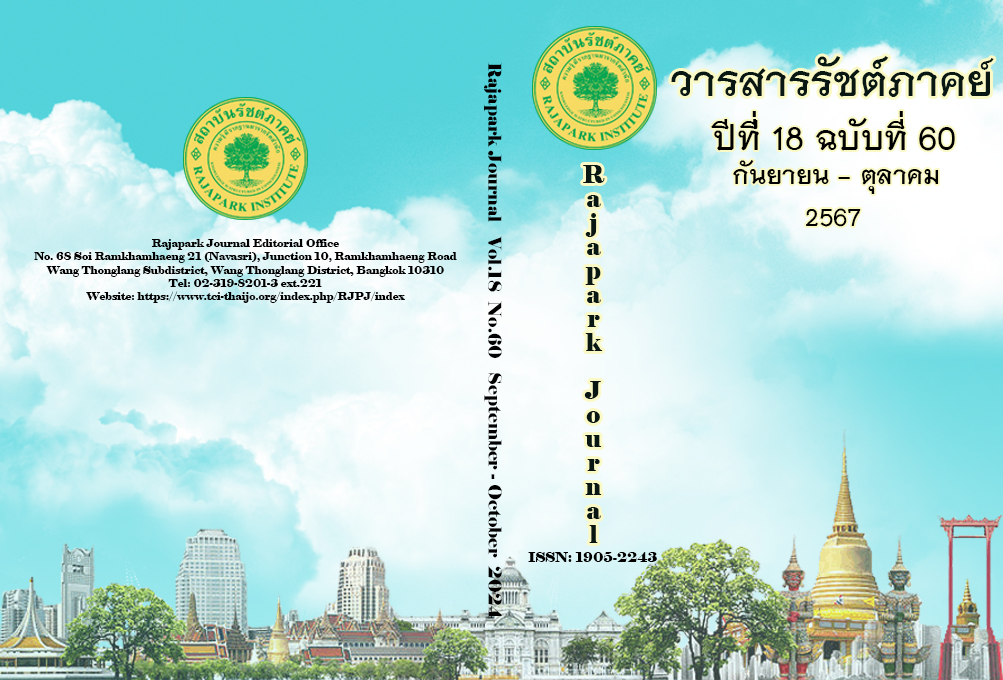The Guideline for Development of Community Model Based on Low Carbon Tourism for Upgrading to A Green Tourist Destination; A Case Study of Agro-Tourism Attraction at Maha–Sawat Canal Phutthamonthon District, Nakhon Pathom Province
Main Article Content
Abstract
The guideline for the development of a community model based on low-carbon tourism for upgrading to a green tourist destination; a case study of agro-tourism attraction at Maha- Sawat Canal Phutthamonthon District, Nakhon Pathom Province. The research aimed 1) to study the potential of the tourist destination. 2) to study the factors affecting an achievement to adapt in the agro-tourism site, and 3) to analyze guidelines for the development of a community model based on low-carbon tourism. The key informants were divided into 3 groups: in-depth interviews with 10 key informants, who related to the agro-tourism site, 10 key informants, who have low-carbon tourism experience, and focus groups with 20 stakeholders. The research results were found as follows: 1) The potential of the agro-tourism site at Maha-Sawat Canal is outstanding with the way of agriculture and followed the rule of sufficiency economy and adapted to their living. There are 6 tourism components, including accessibility, accommodation, attraction, amenity, activity, and ancillary service. 2) The factors affecting an achievement consist of 1) the potential factors of a tourist destination: tourism resources, tourist attraction management, eco-friendly tourism activity, and partnerships. 2) low carbon components; low carbon community; observe and acrylic tourism resources; eco-friendly tourism in 4 aspects, including transportation, tourism activity, local food and accommodation, and 3) other factors; community empowerment, technology, and partnerships. 3) The guideline for the development of a community model based on low-carbon tourism presents a low-carbon model of agro-tourism sites divided into upstream (preparation for the community), the middle stream (development level), and downstream a model community based on low-carbon tourism for agro-tourism sites.
Article Details

This work is licensed under a Creative Commons Attribution-NonCommercial-NoDerivatives 4.0 International License.
Views and opinions appearing in the Journal it is the responsibility of the author of the article, and does not constitute the view and responsibility of the editorial team.
References
Buhalis, D. (2000) Marketing the competitive destination of the future. Tourism Management, 21, 97-116. http://dx.doi.org/10.1016/S0261-5177(99)00095-3
Choibamroong, T. (2008). Annual of international Thai tourism journal 2008. Thailand Science Research and Innovation.
Choochat, C., Wattanalaungarun, W., & Sa-ingthong, K. (2022). The sufficiency economy-based tourism model of the upper Wang River area. Community and Social Development Journal, 23(2), 138-154. https://so05.tci-thaijo.org/index.php/cmruresearch/article
/view/251150
Collier, A., & Harraway, S. (1997). Principle of tourism. Longman.
Cooper, C., & Boniface, B. G. (1998). Geography of travel and tourism. Butterworth Heinemann.
Dachanee, E. (2018). Resources management for forestry. Sukhothai Thammathirat Open University.
Designated Areas for Sustainable Tourism Administration (Public Organization). (2015). Low carbon tourism. Cocoon & Co Company Limited. https://ejournals.swu.ac.th/index.php/JOS/article/view/7046/6560
Esichaikul, R. (2014). Niche tourism management. Sukhothai Thammathirat Open University.
Jaiuea, M. (2020, Dec 13). Low carbon tourism. https://www.blockdit.com/posts/61f544eae97e2ef407851837
Jittangwattana, B., & Srikhampha, P. (2014). Sustainable tourism management (2nd ed.). Dharmasarn.
Kamnedsin, K. (2020). A study of strong community management of Bang Nam Phueng community model. Journal of Humanities and Social Sciences Bansomdejchaopraya Rajabhat University, 14(1), 1-36. https://so08.tci-thaijo.org/index.php/jhusocbru/article/view/1598
Katchwattana, P. (2019, Feb 13). Turn the crisis into an opportunity Looking at ways to survive the tourism business by adapting to 'climate change'. SALIKA. https://www.salika.co/2019/02/13/thai-tourism-fight-climate-change/
Kongprem, N., Keawchaoon, K., & Udomsiilp, M. (2023). The development of mice activity in local tourist attractions according to the local-community identities in the hidden gem plus city, Nakhon Pathom Province. Southeast Bangkok Journal, 9(1), 1-14.
https://so05.tci-thaijo.org/index.php/SB_Journal/article/view/259900
Kupkitaphun, K., & Bunjongmanee, P. (2023). The guidelines of health tourism development of european tourist in Prachuap Khiri Khan province. Journal of Graduate Studies Valaya Alongkron Rajabhat University, 14(1), 1-13.
Laowirojanakul, T., & Sangpikul, A. (2023). The analysis of research works in regard to low carbon tourism: The approaches to the sustainable tourism of the country. Liberal Arts Review, Huachiew Chalermprakiet University, 18(1), 129-143. https://so04.tci-thaijo.org/ index.php/larhcu/article/view/263988
Maraphot, K., & Somboon, T. (2023). The development of agro-tourism routes to promote tourism in Phanom Sarakham District, Chachoengsao Province. Interdisciplinary Social Sciences and Communication Journal, 6(4), 210–223. https://doi.org/10.14456/issc.2023.74
Ministry of Tourism and Sports, Thailand. (2020, Sep 15). Strategy in tourism and sports 2017-2020. https://www.mots.go.th/download/article/article_20171201174031.pdf
Morrison, A. M. (2020). Marketing and managing city tourism destinations. In Routledge Handbook of Tourism Cites. Routledge.
Office of Natural resources and Environmental Policy and Planning. (2023). Low carbon Tourism. http://env_data.onep.go.th/blogs/subject/view/20
Phuwanatwichit, T. (2010). Integrated strategic plainning of tourism development on the R3A northern economic corridor (Chiang Rai- Lunming)[Doctoral Dissertation, Mae Fah Lung University].
Pkalasri, S. (2002). Theories and principles of community development (4th ed.). Odeon Store.
Puangsang, M. (2023). Low carbon tourism: Eco-friendly tourism. Journal of Mahamakut Buddhist University Roi Et, 12(2), 615-627. https://so01.tci-thaijo.org/index.php/AJMBU/article/view/262378
Raihan, A., & Tuspekova, A. (2022). Dynamic impacts of economic growth, renewable energy use, urbanization, industrialization, tourism, agriculture, and forests on carbon emissions in Turkey. Carbon Research, 1(20). https://doi.org/10.1007/s44246-022-00019-z
Sappachang, S. (2016, Dec 26). Low-carbon tourism. https://www.okmd.or.th/knowledge-box-set/articles/thai-travel/656/low-carbon-tourism
Sriget, U. (2022). Community-based tourism for the sustainable development. Western University Research Journal of Humanities and Social Science, 8(2), 270-279. https://so04.tci-thaijo.org/index.php/WTURJ/article/view/259594
Srirathu, V. (2008). Eco-tourism potential of Amphoe Khao Kho, Phetchabun Province[Master’s thesis, Srinakarinwirot University].
Tourism Authority of Thailand. (2020, Oct 20). 7 Greens. http://adventure.tourismthailand.org/7greens.php
Yindeechan, N. (2020). Community communication innovation for enhancing eco – tourism potential: A case study of communities in Khlung District, Chantaburi Province. Kasem Bundit Journal, 23(1), 78-88.


